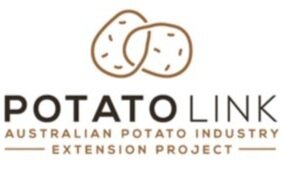Optimising Fertiliser Use: A New Demonstration Trial in North Motton (Tas)
A new demonstration trial in North Motton, Tasmania focused on optimising fertiliser practices in potatoes by evaluating varying rates, timings (pre-spread, at planting, and top-dress), and approaches (crop sampling and conventional programs) to improve grower profitability and potato marketability.
PotatoLink Project Poster at the 2024 World Potato Congress (2024)
PotatoLink attended the 2024 World Potato Congress (WPC) in Adelaide, SA and connected with local industry members, international potato experts and growers. In addition to the PotatoLink stand, Regenerative Potato Production panel session, Hort Innovation R&D Forum, the PotatoLink team also presented a poster showcasing the projects extension and communication strategy and its' engagement with growers to enhance soil health, featuring a grower from Queensland. View the poster here.
Nutrient Use Efficiencies at the Springbank Demonstration Site
The rising cost of inputs has growers searching for ways to enhance nutrient use efficiency and understand its impact on pack-out and yield. A previous trial at the PotatoLink demonstration site in Springbank (Victoria) explored how farm practices impact the effectiveness of biologicals, including fungicide application, soil nutrient availability, and fertiliser use. The positive results from that trial, including improvements in tuber size, quantity, and specific gravity, shaped the objectives for this new trial.
How to Cut Seed Potatoes
Cutting seed potatoes involves four steps: (1) warming seed before cutting, (2) cutting seed potatoes to seed pieces, (3) curing seed pieces, and (4) cooling seed pieces down to a holding temperature. Get a copy of the visual shed poster to assist with best practice and important considerations when cutting seed.
PotatoLink Bulletin - July 2024
PotatoLink Bulletin July 2024 is packed with the latest news an updates for potato growers and all involved in the industry.
101: Managing irrigation
Growing crops in Australia is not for the faint-hearted, especially when it comes to managing water. The challenge lies in the fact that we often have either too little or too much water, and not always at the right time. Farmers cannot rely on gentle, frequent rain to replenish soil water levels; managing water for crops needs deliberate and considered intervention. Read the full article in Issue 13 of PotatoLink Magazine.
Towards reduced emissions on australian potato farms
As the global community grapples with the impacts of climate change, the horticultural sector faces mounting pressure to transition towards more sustainable practices, including reduced greenhouse gas emissions from agriculture production. In Australia, there is plenty of scope for potato farms to adopt various strategies to begin their journey to reduced emissions from production. Read the full article in Issue 13 of PotatoLink magazine.
The front line exotic pest profile: Colorado potato beetle
The exotic Colorado potato beetle (Leptinotarsa decemlineata) (CPB) is globally considered one of the most economically damaging pests to the potato industry. CPB is native to North America and widespread. It has hitchhiked its way to Europe and northern Asia, where it has since spread rapidly and established. Read the full article in Issue 13 of PotatoLink magazine.




















